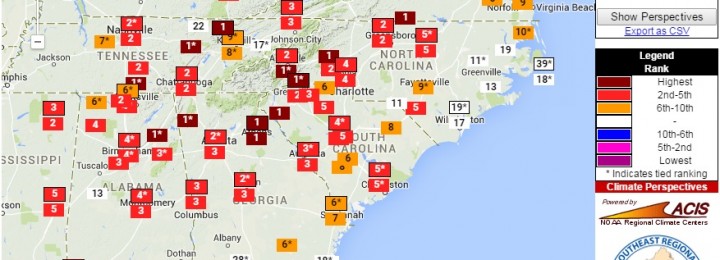Sources of weather and climate data
-

The beautiful weather yesterday set records across many parts of the Southeast. If you are interested in looking at the temperatures or rankings for yourself, the Southeast Regional Climate Center has a good tool called “Perspectives” which allows you to look at the recorded values of recent weather conditions and calculate the ranking of that…
-

Now that spring is here and warmer, more humid air is entering the US, severe weather and tornado chances are increasing across the country. There is an excellent animation that shows how the region of severe weather occurrence moves around the country at the NOAA Storm Prediction Center at https://www.spc.noaa.gov/new/SVRclimo/climo.php?parm=anySvr. The area of most likely…
-

We’re about halfway through March, and so far for the month the Southeast has been warmer and drier than normal across almost the entire region. The warmth has been especially strong in Florida and southern Georgia. Dry conditions in southern Alabama have contributed to the continuing drought there. Generally the coolest temperatures have corresponded with…
-

The National Weather Service has a good graphical forecast tool for hourly weather variables available on their web sites. You can get instructions for how to get one for your location at https://www.srh.noaa.gov/oun/?n=hourlyweathergraph. The forecast has a number of parameters to choose from, including temperature, wind, humidity, rain and other forms of precipitation, thunder, and a variety of…
-

The latest newsletter of the Southeast Climate Consortium is now available on their website here. The SECC is one of the groups that helps support this blog and is a multi-university consortium of scientists interested in looking at climate variability, water and agriculture in the Southeast. The newsletter this month features our new web page…
-

If you’ve ever been asked about how many tornadoes passed through a particular county, or other questions related to tornado statistics, you might find this tornado track tool useful. The Midwestern Regional Climate Center has an interactive tool which allows you to map historical tornado tracks from 1950-2013 across the US, including the Southeast. You…
-

Today’s EDEN (Extension Disaster Education Network) blog has a great entry on lightning and weather safety. Since the weather is warming up and thunderstorms are becoming more common, it’s a good time to review your lightning safety rules. They provide a number of links to resources like the National Weather Service and others. Check out…